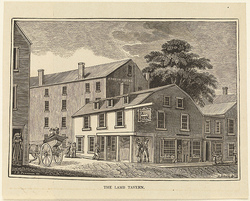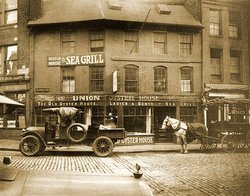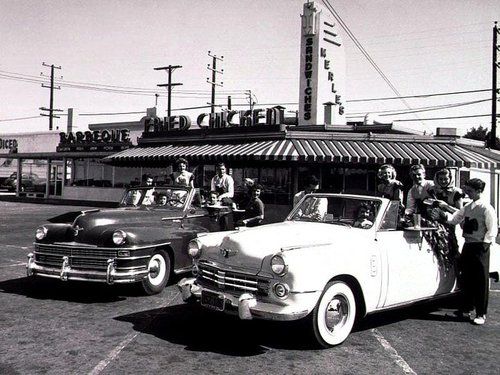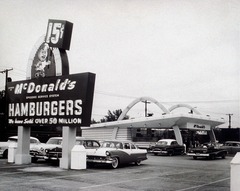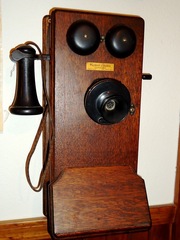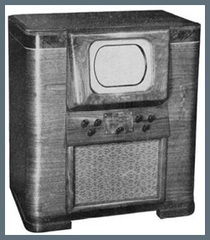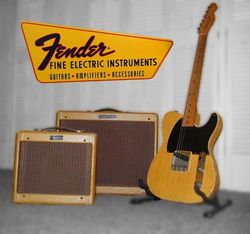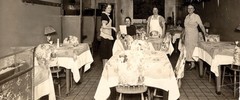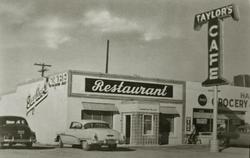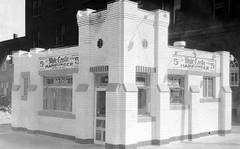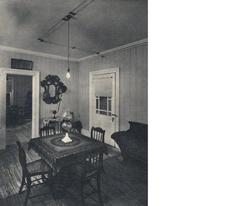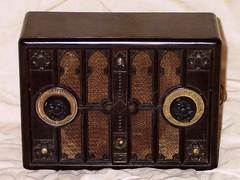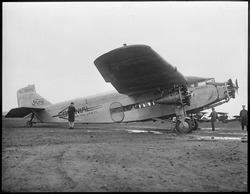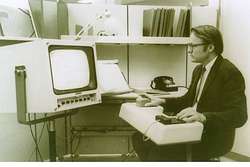History of American Food Service and Technology:
THE UPPER SECTION WILL COVER DEVELOPMENTS IN FOOD SERVICE AND THE LOWER SECTION WILL COVER DEVELOPMENTS IN TECHNOLOGY:
DEVELOPMENTS IN FOOD SERVICE:
From Colonial times to today, there has been a food service industry. Prior to WWII, the vast majority of people ate at home. Family meals were considered very important and were generally served within three distinct time periods. Breakfast, lunch, and dinner were the prescribed times. Even hotel restaurants served food food during these times. It was the developments after the late 1940's which changed traditional patterns. There were certainly resturants in large towns and cities for travelors and business men, but the vast majority of meals were served at home. The exception would be large cities which functioned on a different schedule. Soda fountains, tea rooms, and ice cream parlers were the "snack" vendors of the day. Nearly all restaurants were locally owned till the late 1930's and this continued until the 1950's. Chain resturants began along the railroad routes as did hotel food service. Chain establishments were in the minority till after WWII. The trend toward fast food began in the soda fountains, progressed to "curb side" food service in the late 1930's, and became a full fledged movement after the early 1950's. The developments are far too complex to cover in this short section, however I will attempt to give a very general picture of changes through the decades. Fast food has influenced nearly every type of food service today and it is estimated that since the late 1980's, more meals are served in food service setablishments than in the home!
Below is pictured a tavern from the 1850's:
Typical city restaurant dating from around 1915:
Restaurants existed as early as the Colonial peiod, however during that time they would only be found in larger metropolitan areas or by roads with high traffic. Because meals were served at home, the vast majority of food was served in a family setting. It wasn't till after WWII that this began to be radically changed. Resturants before the 1940's sprimarily served travelers, business people, and at train stops. Nearly all resturants were privately owned till after WWII with only a few exceptions.
Curb side food service grew exponsntially after the late 1930's:
There were restaurents which began to offer "curb side" service in the 1930's but this trend didn't grow much till the early 1940's. It began in California and only in high traffic areas. It was a shift from the soda shop to the ice cream shop, to the ice cream shop with a "grill." As teens began to drive, the curb service grew in huge numbers!
The first McDonalds sold hot dogs in California:
Beginning in the 1930's, the McDonalds brothers built a very successful hot dog stand which later began serving hamburgers. They engineered an assembly line system which allowed them to make food faster and really inexpensively. The brothers, however, could never operate effictevly more than several stands at one time. In the early 1950's Ray Crock, a traveling salesman who was highly motivated, took the restaurants from several locations to thousands. By 1958, McDonalds was one of the largest fast food chains in the US.
____________________________________
____________________________________
The telephone becomes a common item in the home:
Television becomes an important world technology:
The electric guitar has a greater impact on society than most would expect:
Women's tea room dating back to the 1930's. These were the early Starbucks:
Early diners were primarily men's establishments while tea rooms were typically women's establishments. The teas rooms began in the 1700's in England and came over to america in the teens, however were not popular till the 1930's.
Restaurant of the 1940's:
Restaurant establishments began to grow in the 1920's but in low numbers. It was automobile travel which stimulated the growth of the independent restaurant businesses after the early 1930's. There was still food service around the railroad stops, however as Americans began to travel more, the need for food servece establishments grew. It was the "traveling salesman" movement which grew after the mid 1920's which was a huge stimulant to hotel/motel and food service growth (apart form rail service locations).
White Castle is one of the first "fast food" restaurants which was also a "chain" business:
The A & W Rootbeer Stand could be argued to be the first "fast food" service which began in 1919 and had a limited food menu by the early 1920's. White Castle, however, is a better model beginning around 1921.
_____________________________________________
_____________________________________________
DEVELOPMENTS IN TECHNOLOGY SINCE THE 1880'S:
